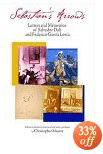Sebastian's Arrows: Letters and Momentoes of Salvador Dalf and Federico Garcfa Lorca

by Edited, translated from the Spanish, annotated, and with a prologue by Christopher Maurer
231 pages,
ISBN: 0967880882
Post Your Opinion | | Brief Reviews. Non-Fiction
by Jeff Bursey
This collection of letters and addresses reads like a handful of scribbled mash notes from
one artistic schoolboy to another. The notes are filled with affectionate, sweeping
pronouncements¨Dali to Lorca (1927): "I think no epoch has ever known the perfection
of ours"¨encomiums or imprecations against those who just don't get what's new¨
Lorca to Dali (1927): "All of us are a little like St. Sebastian when they criticize and
gossip about us"¨and, as passions cool, criticism and wistfulness. It is a very incomplete
picture due to the immense gaps between letters (Maurer indicates it is not known how
many have been lost). A casual reader who is not a Lorca or Dalf scholar will be
frustrated by the silence surrounding the letters, of which more later. The endnotes refer
the curious to "detailed commentaries" by other writers where, presumably, the missing
incidents will be supplied.
The courtship between Dalf (1904-1989) and Lorca (1898-1936) began, as Maurer tells it,
in 1923 at a college in Madrid. They continued an artistic relationship through letters and
visits from 1925 to 1936. St. Sebastian proved a complex and protean figure for each, in
contexts both intimate (letters) and public (paintings and drawings, addresses or articles),
and helped to reflect their views on art (nine years before his execution by Falangists,
Lorca told Dalf that St. Sebastian was "martyred for political reasons") as well as on the
homosexual aspect of their friendship, which is nicely glossed in the prologue. "Didn't
you ever think how strange it is that [St. Sebastian's] ass doesn't have a single wound?"
Dalf wrote in September 1926. This is a reference, and a tweak, to how the painter never
let the poet possess him sexually. In the endnotes Dalf is quoted as saying: "Not having
succeeded in persuading me to put my ar¨ at his disposal, he swore to me that the
sacrifice exacted from the girl was compensated by his own: it was the first time he'd had
intercourse with a woman." In 1927 Lorca wrote, "I wanted to throw myself from the car
so that I could stay with you . . . I realize now what I've lost by our separation." In the
last letter, Dalf is still calling Lorca "dear", and sending him "a big hug".
Apart from the stock hearts-and-flowers and recognition of each other's uniqueness, the
tone of the thirty-nine letters is a bit peculiar. Of the twelve written by Lorca, seven are to
Dalf's sister, Anna Maria. Dalf's contributions are vigorous, cocky, and schoolmasterish,
whereas Lorca's are fuzzily romantic, strained and tentative. He appears inauthentic and
merely reactive when he writes: "I can't understand why I need to look again and again at
my fingernails while I read your poems. They make me feel as though a cat's hair had
gotten into my blood." It seems that the words of his friend had gotten to him and he
could only reply with a watered down version of Dalf's frequent wordplay. Lorca's "St
Lucy and St. Lazarus", a sort of story, is reprinted in Sebastian's Arrows, and it shows
that his attempt at being a Surrealist is unconvincing; he wants to look fashionable in the
new style but can't put his soul into it. "Sketch of the New Painting", where Lorca
declares Surrealism the pinnacle of art, is filled with the vanity that adherents of every
movement possess, in addition to a disquieting pride about things Spanish which comes
across as nationalistic and terribly naive. For his part, Dalf begins with a tenderness equal
to Lorca's and a humour Lorca never has, but by September 1928 his appraisal of The
Gypsy Ballads is blistering: "Your poetry is tied hands and feet to the old poetry. You
probably think some of your images very bold, but I can assure you that your poetry
moves within the illustration of the commonest and most conformist of commonplaces."
Thanks to the scarcity of letters, the next one comes from the summer of 1930, so the
reader turns to the notes to read about Lorca's reaction to such harshness. There is no
note detailing whether he was hurt, amused, or chastened. The prologue anticipates some
questions, but by no means covers the many topics Lorca and Dalf throw out. While
Sebastian's Arrows is a handsome book, with photographs that include reproductions of
artwork and facsimile pages, the notes are, at times, abysmal. There is nothing within any
given letter, or even the prologue, that signals there might exist a note attached to this
movement or that figure. Consequently, a reader must keep going from the main body of
the book to the notes. Such explanatory material could have appeared as footnotes
following each letter, as most are quite short. There are numerous typographical errors
throughout, and lastly, notes for one letter are merged with those for another, or attributed
to the wrong letter. These small errors cause considerable aggravation.
It might be asked whom Maurer had envisioned as reader for this book. It isn't put
together well enough for academics, though by what it leaves unsaid, clearly it's assumed
Dalf or Lorca specialists are the only ones who could fill in the considerable blanks. The
price will deter the general reader; better to borrow it from a library. But the best route
might be to read biographies in which the letters are quoted within larger examinations of
the lives of the painter and the poet. ˛
|